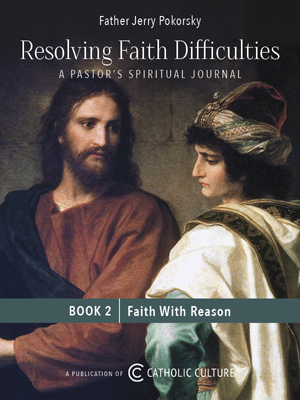Catholic Activity: Christmas Play
Another wonderful way to instill the love and joy of Christmas is by acting out the Christmas story in dramatic form. Here are some suggestions on how to put on a Nativity Play.
DIRECTIONS
As children we were all able to concoct plays of one sort or another. They were plays with plenty of dressing up, much singing, little scenery or props. But there is something about these plays — crude, pitiful, absurd as they were — that keeps them in the mind when memories of real plays, with real actors, in real theaters, have long since gone.
There were two reasons for this, I think. The first and obvious one is that as children we did not merely act the story, we lived it; it meant something to us, we were in deadly earnest about it. And the second reason — which helped to make possible the first — is that there was no audience looking on. The play was not given for the sake of an audience, but for its own sake. It ceased to be a play, impersonation; it became reality.
The only requirements for making a home-produced nativity play a success are the very ones that went to make the success of the children's plays — that the story you are acting should be real to you, should mean something. If you want to have a nativity play at home, with all the family joining in, then it is no good trying to deal objectively with the story of the first Christmas. An impartial play about Christmas will be a useless play.
Then, be firm and have no audience, no one to watch and criticize how you acquit yourself. Audiences spell self-consciousness to those who act, and self-consciousness makes impossible any real "living" of the play. It is only when everyone present is joining in that it can become real, that it can be lived, that it can indeed become real adoration.
But how to set about the actual play?
First, cut the cast to suit your circumstances. If need be you can act it with three people — a narrator, one angel, one shepherd. But if your family or friends run to it you can have angels and shepherds by the dozen. If you insist, get people to represent our Lady and Saint Joseph. However, it is generally far more satisfactory to use the Christmas crib as the center of the play. If you are at all interested in producing a Christmas play at home, then it is fairly certain that you will already have a crib put up somewhere in the house. So this does not call for any difficulty. Then divide up the available people into angels, shepherds, wise men, people of Palestine — and on these last you can ring enough changes to suit any sort of family, with members of any age.
Dress up for the play. The most stolid and bovine people can be transformed into new beings simply by dressing up. Whether the dresses look at all oriental is of no importance; in any case, few of us have more than a vague idea of what was worn in the days of Christ. The main thing is that those who take part are helped to get out of their ordinary, everyday selves; and few things are more helpful for this than setting aside the dress of everyday. With the new dress a new character is put on.
The basis of the play lies ready in the words of St. Luke. One person might read the story slowly and with care while the others act what is being read. No one can lay down rules about this. In one family they may like to mime the Gospel story; in another the narrator will have to be content with lengthy pauses while angels and shepherds and Palestinians hold impromptu conversation for as long as the spirit moves them. It is important to keep as much of the dialogue as possible spontaneous. This is not a stage play; there is no audience to satisfy. This is really an act of prayer. And though indeed a stage play can also be a prayer, still all the same, a stage play must be practiced, rehearsed, perfected. Not so the play at home. Let it be rough and ready, with little or no stage craft, certainly with no conscious striving for polish or perfection. Sing as many carols as you know. Putting it at the lowest level, a carol will always fill up any unexpected hitch in the play. Putting it higher, carols can make the play into a real prayer. Here the story is acted for its own sake, to make it a reality, so that those who are joining in may live it and make an adoration of it.
There is plenty of precedent for this sort of homely play. When St. Francis of Assisi re-introduced the crib into Europe he did it with a little play, acted spontaneously by a group of brothers and himself. St. Teresa of Avila often acted the Christmas story with her nuns. Every Christmas-eve St. John of the Cross and the friars held a nativity procession in the monastery. They took a statue of our Lady, and two of them carried it from cell door to cell door, asking for shelter for Mary and her Child. Those within had to refuse, and would join on to the end of the procession as it went from door to door, always being refused. Then at last the procession wended its way into the chapel and presently the statue of the Christ-child would be laid in the straw of the manger. So immersed were those who took part, so much did they live the story, that it is related that on more than one occasion John of the Cross, unable to contain himself for joy that Christ was born, plucked the child from the manger and danced round the chapel, holding it in his arms.
Activity Source: Candle is Lighted, A by P. Stewart Craig, The Grail, Field End House, Eastcote, Middlesex, 1945






